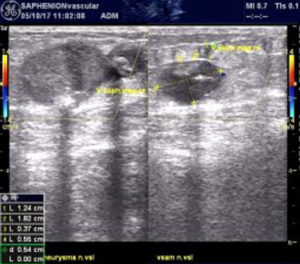Cyanoacrylate glue is used extensively now for the closure of refluxing saphenous trunks, occasional deep tributaries and some perforating veins. The advantage over endothermal methods of closure is that tumescence is not needed. However, tumescence will be required for the actual varicose veins if they are removed using phlebectomies in a local anaesthetic setting.
It works by glueing together the inner wall of the vein using a “spot welding” technique. The glue acts as a foreign body causing a granulomatous inflammatory reaction which can be seen on ultrasound as a prominent acoustic shadow. After several months this disappears eventually leaving behind a small hypo-echoic vein lumen without flow. Early side effects may include palpable lumps in a thin patient, local itching, generalised urticaria and very rarely anaphylaxis.
ULF THORSTEN-ZIERAU We have extensive experience in the use of the non-thermal non-tumescence cyanoacrylate glue closure system since 2012.
Clear advantages over endothermal techniques, like radiofrequency and laser, is that painful tumescence is not required and all refluxing saphenous veins in both legs can be treated at the same time. Since the treatment does not involve high temperatures to destroy the vein, surrounding nerves are not involved in the heating process. Consequently, nerve complications like paraesthesia, hyperaesthesia and numbness do not occur. This is most important with the small saphenous vein where surrounding nerves are not always visible on ultrasound. Furthermore, the vein is closed with the glue thereby avoiding the risk of a thrombophlebitis with resulting pain and skin pigmentation.
Larger veins and even saphenous aneurysm can be sealed successfully with glue. However, this requires meticulous technique with precise deployment of the glue and ultrasound probe pressure.
Over 1700 truncal veins have been treated so far in over 940 patients and have been followed up to 65 months. These include the great, small and accessory saphenous veins. Although post-procedural compression is not required as part of the protocol, compression stockings are advised in many patients because chronic venous insufficiency is a chronic disease and compression improves the venous drainage. Our long-term closure rate is 97% and all the venous leg ulcers treated in this way healed. In comparison to endothermal techniques, pain scores are low, complications are rare and patient satisfaction is very high.
Junctional aneurysm of the great saphenous vein sealed with glue. Note the acoustic shadowing.
